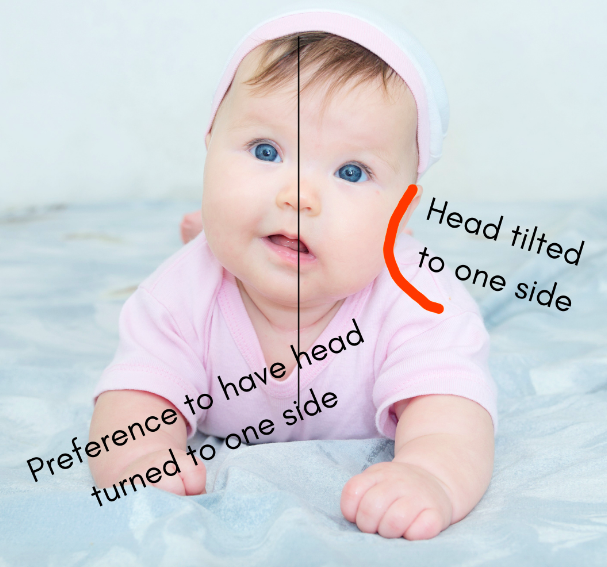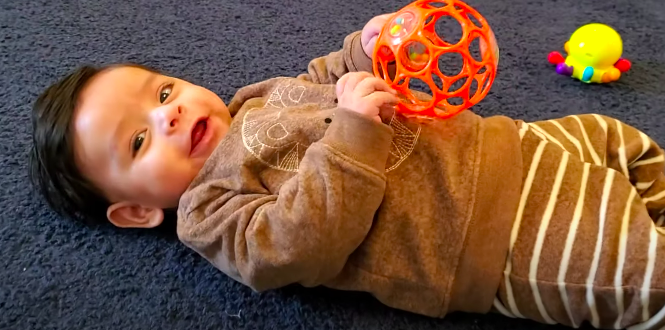Torticollis Baby Exercises
These torticollis baby exercises can be done at home or in conjuction with your doctor or physical therapist. These exercises include mobility, movement, play, strength, tummy time and stretches. They should be done slowly and gently. By working with a physical therapist you can determine if you baby has torticollis, if it is to the right or to the left side, and the best exercises and course of treatment for your baby.
Do the torticollis baby exercises slowly and gently such as this stretch
What is Torticollis in Babies?
Torticollis, is a condition in which a baby's neck muscles are tight on one side, causing them to tilt their head and limit their range of motion. Read our blog post to learn more about what is torticollis in babies.
Torticollis, is a condition in which a baby's neck muscles are tight on one side, causing them to tilt their head and limit their range of motion.
Torticollis Signs
Preference to look to one side
The head is usually tilted to the opposite side
Difficulty turning the head
Flat head (or plagiocephaly)
Trouble with breast feeding on one side
Preference to roll one direction or to reach with one hand
Facial asymmetries such as one cheek may appear fuller, or one eye may appear smaller
Is it Torticollis to the Left or Right Side?
It important to know if you child has torticollis to the left or right side in order to do the proper movements and exercises. A physical therapist can help you determine this if you have any questions. Left torticollis is a tightening of the muscles on the left side of the neck. It results in your child often bending his or her head to the left side and looking to the right side. Right torticollis is a tightening of the muscles on the right side of the neck. It results in your child often bending his or her head to the right side and looking to the left side.
Torticollis Baby Exercises
Here are some exercises that you can use with you baby if they have been diagnosed with torticollis by a health care professional or if you have noticed signs of torticollis. The exercises include:
Playing in midline
Tracking side to side
Side lying play
Transitioning from back to belly
Assisting to lift the head up
Tummy Time
Mobility Sequence For Babies with Torticollis
This video shows a great movement sequence that can be used as preparation before stretching or physical therapy. This baby mobility sequence can help your baby move their shoulders and pelvis.
Tummy For Babies With Torticollis
Tummy time with your baby is often a great exercise if they have torticollis. Lorena Vargas, Physical Therapist, explains tips on how to make tummy time easier for your baby to tolerate.
Tummy time plays an important role in babies’ development, and needs to be part of their daily routine. It has many benefits such as visual stimulation, increase of head control and neck strength, and the development of other motor skills such as rolling over, sitting and crawling. For these reasons, a baby needs the opportunity to play on their tummy during waking hours for at least 60 minutes/day by 3 months of age.
Routine of Exercises for Babies with Torticollis
Lorena Vargas, Physical Therapist, shares a routine of exercise to help your baby with torticollis. These exercises should only be performed with the diagnosis and consent of a pediatrician or physical therapist. In this video, two stretches are shown to help relax your baby's neck muscles. **PLEASE BE CAREFUL AND VERY GENTLE** with these stretches. These stretches should not be forced or painful for the baby. If your baby doesn't tolerate these stretches, place a toy on the side that they do not prefer to have their head turned and try to entertain them there for several seconds to minutes. Other exercises like moving the pelvis and shoulders, playing with both hands, and doing tummy time help your baby recognize and explore their environment.
Some torticollis baby exercises focus on achieving milestones such as rolling, tummy time, sitting and standing.
Torticollis Treatment with Physical Therapy
Physical therapy is a highly effective treatment for a baby with torticollis. A physical therapist will work with your baby to improve their neck range of motion and muscle strength. PT may include:
● Stretches to lengthen the tight muscles.
● Range-of-motion exercises to help your baby turn their head to both sides.
● Strength-building torticollis baby exercises to improve muscle tone and coordination.
● Exercises to facilitate developmental milestones based on age appropriate skills.
It is important to start physical therapy as soon as possible, as early intervention can lead to a full recovery. With the help of a physical therapist, your baby can regain full range of motion and muscle strength and avoid long-term difficulties.
What to Expect During your Baby’s Torticollis Treatment?
After an initial evaluation, the physical therapist will determine the main goals to work on based on the family’s concerns, the baby’s corrected age, and the baby’s strengths and challenges.
Physical therapy treatment for torticollis, focuses on improving neck mobility, facilitate correct alignment and promote developmental milestones through family education and environmental adaptations.
Book a consult to let us know how we can help your baby to correct alignment and to reach their milestones.



